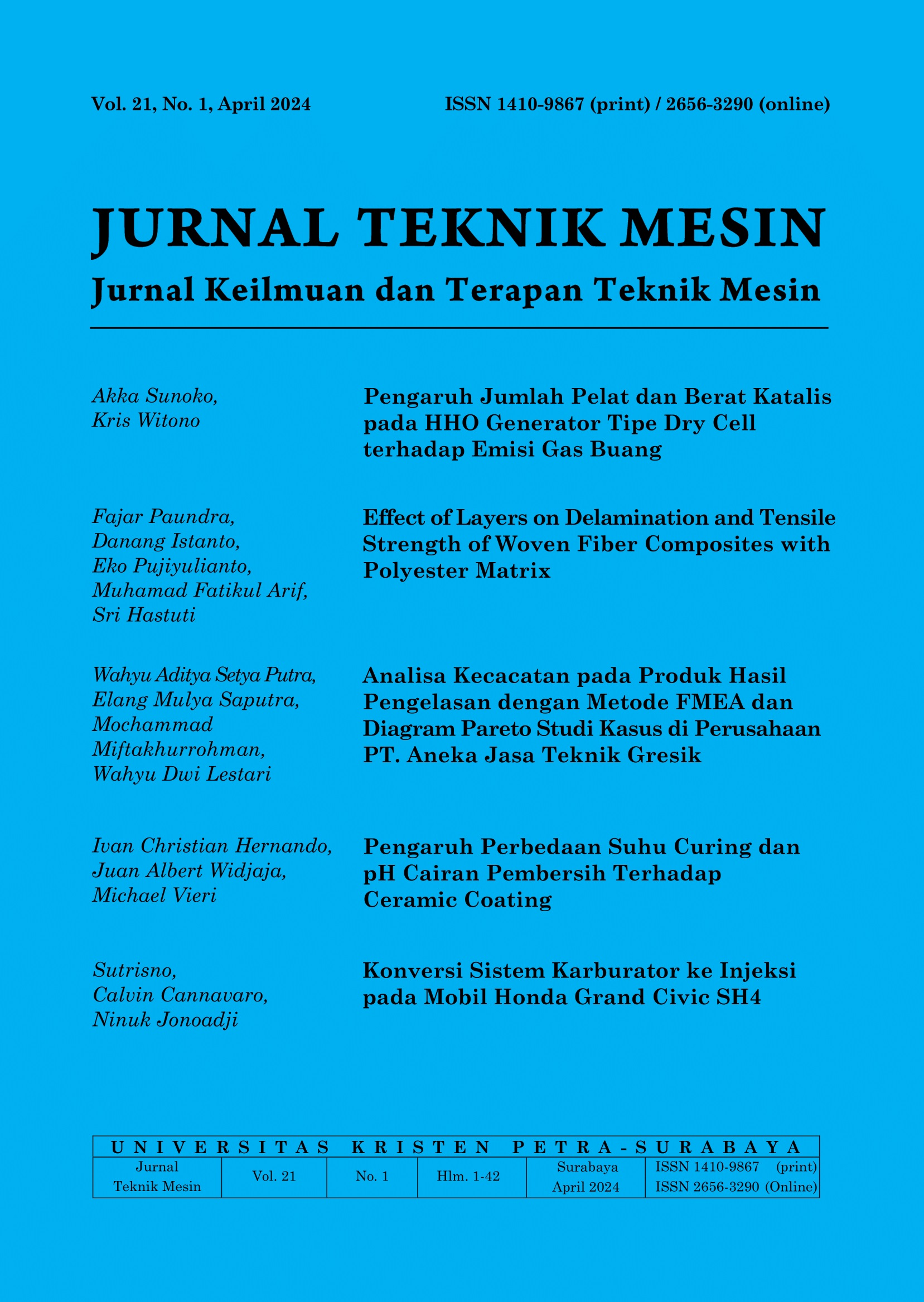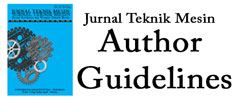Effect of Layers on Delamination and Tensile Strength of Woven Fiber Composites with Polyester Matrix
DOI:
https://doi.org/10.9744/jtm.21.1.11-20Keywords:
composite, delamination, layers, tensile strength, holeAbstract
A composite is a combination of 2 or more different materials. The composite joining process can use adhesives or mechanically by making holes. During the process of making holes in the composite, it can cause delamination in the composite. Delamination and layer thickness greatly influence the strength of hollow composite joints. This research aims to determine the effect of delamination factors and the number of layers on the tensile strength value of the composite. The materials used in this research are polyester resin and woven glass fiber. The method used is vacuum bagging with variations in the number of layers, namely 3 layers, 4 layers, 5 layers, and 6 layers. Tensile testing refers to ASTM D638 standards. Specimens that have been cut according to standards will then be perforated in the center with a hole diameter of 4 mm using a milling machine. The highest tensile strength value was obtained in the 6-layer variation of 237.448 MPa and the lowest value was obtained in the 3-layer variation of 186.221 MPa. The delamination value greatly influences the tensile strength of the composite, where the more layers, the delamination value will decrease and increase the tensile strength of the composite.
References
. J. M. Mesin, F. P. Nurrullah, F. Paundra, A. Maulana, and A. Muhyi, “The Effect of Webbing Angle Orientation on Physical and Mechanical Properties of Boehmeria Nivea Fiber,” vol. 24, no. 1, pp. 25–34, 2023.
. L. Diana, A. G. Safitra, and M. N. Ariansyah, “Analisis Kekuatan Tarik pada Material Komposit dengan Serat Penguat Polimer,” vol. 4, no. 2, pp. 59–67, 2020.
. F. Paundra, Z. Z. Muttaqin, F. P. Nurullah, E. Pujiyulianto, F. Budi, and R. Artikel, “Pengaruh Variasi Fraksi Volum Terhadap Kekuatan Tarik Komposit Hybrid Berpenguat Serat Pelepah Pisang Dan Serat,” pp. 6–8, 2022.
. A. A. Ansari, S. K. Dhakad, and P. Agarwal, “Investigation of mechanical properties of sisal fibre and human hair reinforced with epoxy resin hybrid polymer composite,” Mater. Today Proc., vol. 26, no. xxxx, pp. 2400–2404, 2019, doi: 10.1016/j.matpr.2020.02.513.
. K. Diharjo, “Kajian Pengaruh Teknik Pembuatan Lubang Terhadap Kekuatan Tarik Komposit Hibrid Serat Gelas Dan Serat Karung Plastik,” Teknoin, vol. 11, no. 1, pp. 55–64, 2006, doi: 10.20885/teknoin.vol11.iss1.art4.
. L. Kristianto, “Pengaruh Persentase Serat Fiberglass Terhadap Kekuatan Tarik Komposit Matriks Polimer Polyester,” pp. 1–94, 2018.
. D. A. Ofori et al., “No 主観的健康感を中心とした在宅高齢者における 健康関連指標に関する共分散構造分析Title,” Molecules, vol. 2, no. 1, pp. 1–12, 2020, [Online]. Available: http://clik.dva.gov.au/ rehabilitation-library/1-introduction-rehabilitation%0Ahttp://www.scirp.org/journal/doi.aspx?DOI=10.4236/as.2017.81005%0Ahttp://www.scirp.org/journal/PaperDownload.aspx?DOI=10.4236/as.2012.34066%0Ahttp://dx.doi.org/10.1016/j.pbi.201.
. K. Diharjo et al., “Adhesive nanosilica/aluminium powder-Epoxy for joint application on composite car body of electrical vehicle,” Proc. 2013 Jt. Int. Conf. Rural Inf. Commun. Technol. Electr. Technol. rICT ICEV-T 2013, pp. 13–17, 2013, doi: 10.1109/rICT-ICeVT.2013.6741521.
. T. Mishra, P. Mandal, A. K. Rout, and D. Sahoo, “A state-of-the-art review on potential applications of natural fiber-reinforced polymer composite filled with inorganic nanoparticle,” Compos. Part C Open Access, vol. 9, no. May, p. 100298, 2022, doi: 10.1016/j.jcomc.2022.100298.
. F. Paunda et al., “Pengaruh Variasi Fraksi Volum Serat Tandan Kosong Kelapa Sawit Dan Serat Ampas Tebu Terhadap Kekuatan Tarik Komposit Hybrid Bermatrik Polyester,” J. Foundry Politek. Manufaktur Ceper 12 J. Foundry, vol. 5, no. 1, p. 2022, 2022.
. I. Rodriguez, D. Soriano, G. Ortiz-De-Zarate, M. Cuesta, F. Pušavec, and P. J. Arrazola, “Effect of Tool Geometry and LCO2Cooling on Cutting Forces and Delamination when Drilling CFRP Composites Using PCD Tools,” Procedia CIRP, vol. 108, no. C, pp. 752–757, 2022, doi: 10.1016/j.procir.2022.03.116.
. M. Kanugraha and N. Iskandar, “Pengaruh Fraksi Massa Serat Terhadap Kekuatan Impak Komposit Berpenguat Serat Rami Dengan Matriks Gondorukem,” J. Tek. Mesin S-1, vol. 10, no. 3, pp. 271–276, 2022.
. R. Benyettou et al., “Assessment of induced delamination drilling of natural fiber reinforced composites: A statistical analysis,” J. Mater. Res. Technol., vol. 21, pp. 131–152, 2022, doi: 10.1016/j.jmrt.2022.08.161.
. H. Hosseini-Toudeshky, M. Jalalvand, and B. Mohammadi, “Delamination analysis of holed composite laminates using interface elements,” Procedia Eng., vol. 1, no. 1, pp. 39–42, 2009, doi: 10.1016/j.proeng.2009.06.011.
. T. S. Kamid, I. D. . A. Subagia, and I. K. G. Wirawan, “Karakteristik Komposit Hibrida Serat Basalt – Karbon Epoksi Resin pada Perendaman Air Laut,” J. METTEK, vol. 5, no. 1, p. 57, 2019, doi: 10.24843/mettek.2019.v05.i01.p08.
. M. H. Nguyen and A. M. Waas, “Modeling delamination migration in composite laminates using an enhanced semi-discrete damage model (eSD2M),” Int. J. Solids Struct., vol. 236–237, no. December 2020, 2022, doi: 10.1016/j.ijsolstr.2021.111323.
. U. A. Khashaba, “Mechanics of chip, delamination, and burr formation in drilling supported woven GFRP composites,” Alexandria Eng. J., vol. 79, no. March, pp. 181–195, 2023, doi: 10.1016/j.aej.2023.08.004.
. Y. Ji, Y. Chen, B. Yuan, X. Hu, and Y. Qiao, “Repair of delamination-cracks in CFRP using CNT-containing resin pre-coating solution through capillary action,” Compos. Part C Open Access, vol. 9, no. May, 2022, doi: 10.1016/j.jcomc.2022.100330.
. M. Ubago Torres and M. Jalalvand, “Additive binding layers to suppress free edge delamination in composite laminates under tension,” Compos. Part A Appl. Sci. Manuf., vol. 156, no. December 2021, p. 106902, 2022, doi: 10.1016/j.compositesa.2022.106902.
. C. Agrawal et al., “Experimental investigation on the effect of dry and multi-jet cryogenic cooling on the machinability and hole accuracy of CFRP composites,” J. Mater. Res. Technol., vol. 18, pp. 1772–1783, 2022, doi: 10.1016/j.jmrt.2022.03.096.
Downloads
Published
Issue
Section
License
Copyright (c) 2024 Fajar Paundra, Danang Istanto, Eko Pujiyulianto, Abdul Muhyi, Sri Hastuti

This work is licensed under a Creative Commons Attribution 4.0 International License.
Jurnal Teknik Mesin is publihed by the Mechanical Engineering Department, Petra Christian University, Indonesia
![]()
All articles and their contents are published and distributed under the international license of Creative Commons Attribution License (CC BY).



















